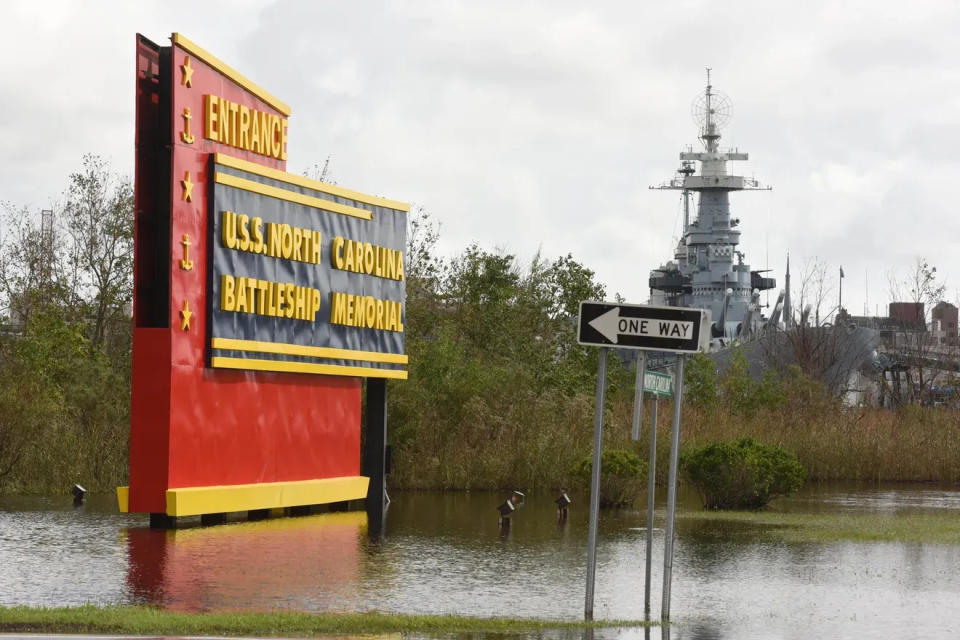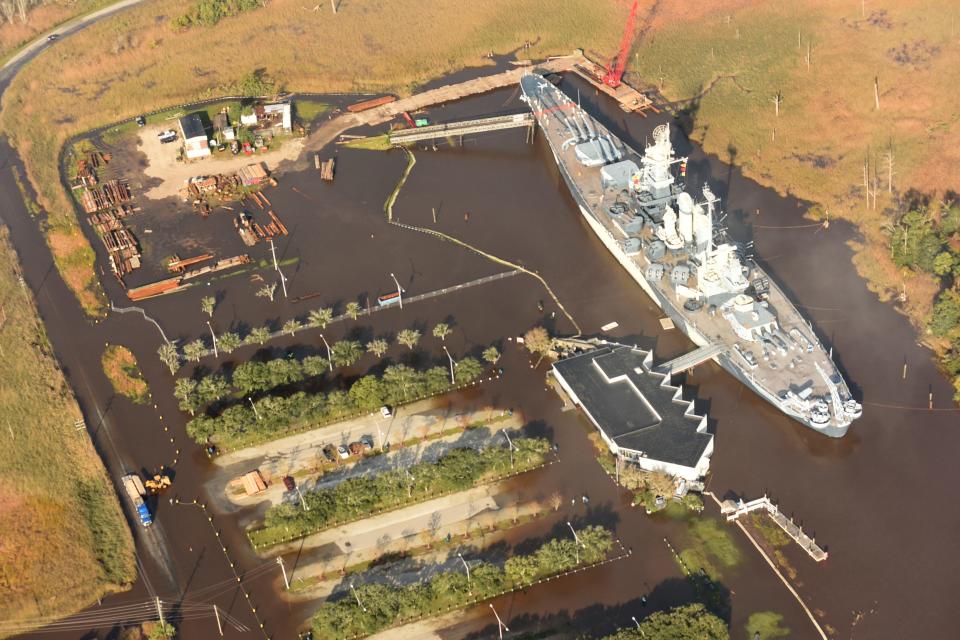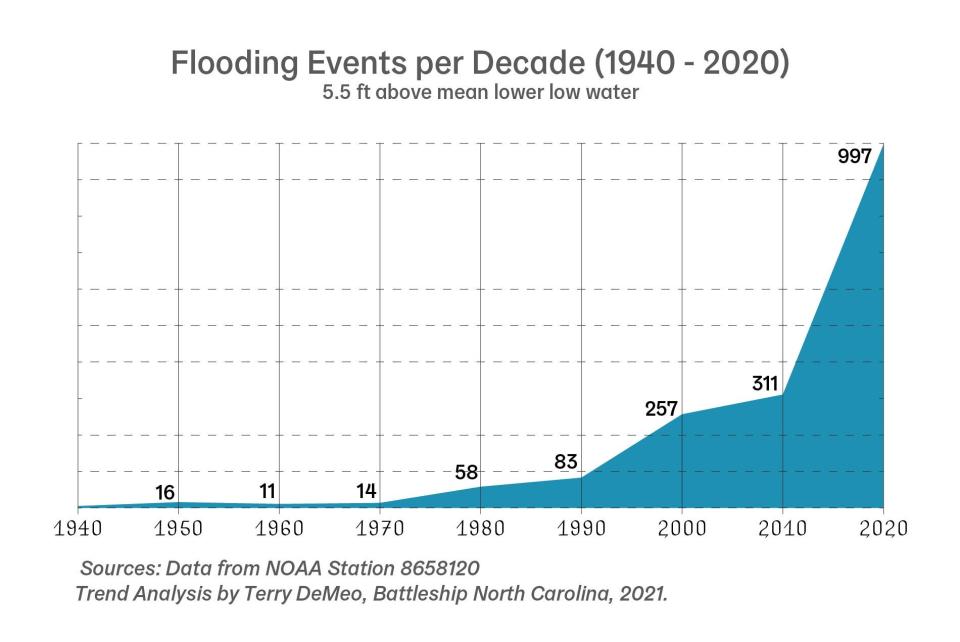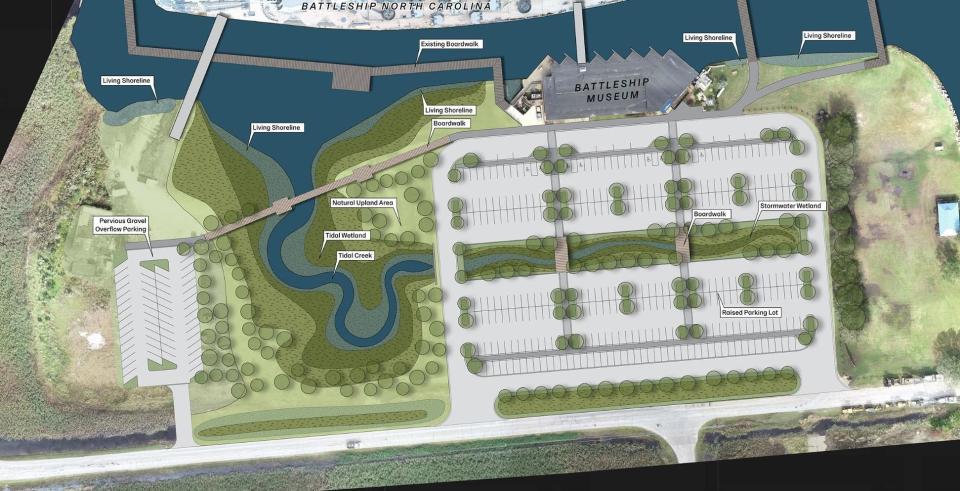Why officials are betting on wetlands to keep the Battleship North Carolina afloat
In the Wilmington area's extensive hurricane history, Isaias wasn't a particularly notable event. While the Category 1 storm did spawn several tornadoes and cause damage in a couple Brunswick County beach towns, the August 2020 hurricane largely stayed offshore and moved through the region quickly.
But it was a different story 26 miles up the Cape Fear River at the Memorial Bridge. There, home to Wilmington's official tide gauge that has been recording water levels since 1908, Isaias pushed enough water up the river channel to set a record for the highest reading ever recorded in the Port City.
For the Cape Fear region, the record-setting water level was a sign of the times and a reminder of the challenges the area could face in the future as climate change continues to cause sea levels to rise and warming ocean temperatures create more fuel for tropical storms to become larger and more powerful.
But for the Battleship North Carolina, that future is already here. The highest decorated American battleship of World War II that's now a floating memorial to the more than 11,000 Tar Heel State residents who died during the war is already battling the rising river.
This is a fight, however, the 35,000-ton and heavily armed warship, berthed along low-lying Eagles Island across from downtown Wilmington and surrounded by ecologically valuable wetlands, can't win on its own.

On Oct. 24 officials are scheduled to open bids for the battleship's "Living with Water" project, a model design that in many ways that will be testing new on-the-ground natural methods and techniques to see if a public site can learn to adapt with its changing environment rather than trying to engineer ways to control it.
Capt. Terry Bragg, the battleship's executive director, said a re-naturalization project using living shorelines, creating new tidal marshes, and parking lot improvements is seen by battleship officials as a better way of combating the environmental challenges facing the historic site − even if it isn't likely to offer a permanent solution.
"These 'green solutions' won't prevent the impacts of climate change, but they offer us a way to try and mitigate some of the effects while blending in with Mother Nature's constraints," he said. "Climate change is very dynamic, and the rate of problems are happening at such a pace that this will be a good snapshot in time to see if projects like these are worthwhile as we see climate change happening over the next 10 to 15 years."
PHOTOS: Battleship North Carolina in action

Increased tidal flooding
For a historic site that literally floats, it might seem a bit ironic that the battleship is having problems handling water.
But it wasn't always that way.
Last decade as the tidal flooding at Eagles Island grew worse, the battleship commissioned a study to see what was going on. The study showed a more than 7,000% increase in tidal flooding since the battleship came to Wilmington in 1961 and 2020. Between just 2011 and 2020, there was an eyewatering 770% increase in flooding events − a figure that's likely increased since then as researchers document sea-level rise increasing.
"During the decades of the 1950s and 1960s we may have seen four to five flooding events a year," Bragg said. "The last decade, over 50% of the year we've had flooding events."

WATER WOES Are NC's 'ghost forests' a canary in the coal mine for upcoming coastal change?
For the battleship, a wet parking lot or standing water on U.S.S. North Carolina Road, which links the battleship to U.S. 421, isn't just an inconvenience.
"By law we're not financially supported by the state of North Caroilna for our operational costs, so if we can’t sell tickets, sell merchandise, we can’t survive," Bragg said. "So this is really extremely important to keeping the doors open and keeping the visitors coming and generating the revenue we need to survive."
He added that the battleship, already the region's most popular tourist attraction, in 2023 is having its best financial year in more than 20 years, setting records for visitation and merchandise sales.

From parking lot to wetlands
Faced with an evolving environment and keeping financial considerations in mind, battleship officials decided to look to nature to deal with their growing water woes.
“This is not the most technically complex project we’ve ever done," Bragg said, alluding to the coffer dam and other restoration projects the battleship has done in recent years. "But from a design, environmental and permitting point of view, this is distinctly the most complex project we’ve been involved in."
Much of the project involves recreating much of the battleship property to reflect the changing environment on Eagles Island. A large part of the "Living with Water" work will deal with the battleship's problematic parking lot, which is often flood prone at even normal high tides. Crews plan to remove about 2 acres of the parking lot on the western side and restore the area to wetlands divided by a tidal creek. Bragg said this should help capture and absorb high tides, while the tidal creek will direct water back to the Cape Fear River.
The rest of the battleship's parking lot will be raised above the high-tide mark, and "green" stormwater measures will be constructed to treat runoff before it reaches the river and adjacent wetlands. That work will include nearly 100 trees and shrubs in the parking lot and more than 130,000 native marsh plants in the wetlands and tidal creek to help improve water quality, habitat creation and carbon sequestration.
MORE Living shorelines: Along the N.C. coast, preparing for rising waters with natural remedies

The project will also include the transformation of nearly 800 feet of eroding shoreline on either side of the visitors center to a living shoreline, where natural features like sea grasses, oyster reefs and rock sills are used to help buffer areas from waves and storm action and create habitat for a host of marine critters.
Bragg said one of the most exciting parts of the project is that it will be an easily accessible "living classroom" for researchers and students to see how green infrastructure works and reacts in a real-world environment that's rapidly undergoing alterations fueled by climate change. The battleship already has partnered with NOAA's National Center for Coastal Ocean Science to help with plant selection and monitoring efforts, and intends to team up with the University of North Carolina Wilmington's Benthic Ecology Lab for permit-required biological monitoring.
What's next?
With any public project, knowing whether you have enough money for the work isn't really known until the bids are opened.
But Bragg said $1 million included in the recently approved North Carolina state budget for the "Living with Water" project coupled with nearly $3 million previously secured from federal and state grants and funding from the N.C. Department of Natural and Culture Resources has the battleship confident it can start moving forward − even if some further fundraising or dipping into savings might be required to get across the finish line.
The project is expected to take about eight months, and Bragg said it will be done in phases to keep visitor access to the battleship open and inconveniences down to a minmum.
A bigger question, though, is what happens around the battleship with future developments and potential impacts from climate change.
RISING WATERS New studies show 'unprecedented' sea-level rise along the North Carolina coast
The Port of Wilmington is pushing to have the Cape Fear River shipping channel deepened from the current 42 feet to 47 feet − a move that would allow more water to push up the river into downtown Wilmington. Development across the Wilmington area, which is one of the fastest-growing metros in the country, also means more runoff flowing into the Cape Fear and Northeast Cape Fear rivers, which merge just north of the battleship.
But it is the unknowns about future changes associated with continued climate change that could have the biggest effects. Numerous studies forecast sea-level rise to increase in the coming decades as the planet continue to warm, and the Carolina coast already has some of the highest rates of rising seas in the country. Increased rainfall in inland areas, including larger rainfall events tied to stronger tropical storms, also would mean more water cascading into the Cape Fear River watershed as it makes its way toward the ocean.
“We’re hoping to be ahead of the curve for a number of years," Bragg said, ticking off all the environmental, safety and infrastructure benefits associated with the upcoming project. "But I don’t think this is the final answer."
Reporter Gareth McGrath can be reached at GMcGrath@Gannett.com or @GarethMcGrathSN on Twitter. This story was produced with financial support from 1Earth Fund and the Prentice Foundation. The USA TODAY Network maintains full editorial control of the work.
This article originally appeared on Wilmington StarNews: Battleship North Carolina looks to green solutions to help with flooding
